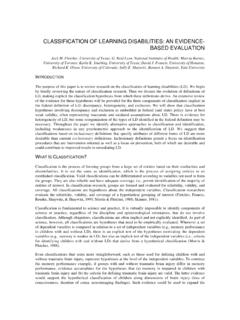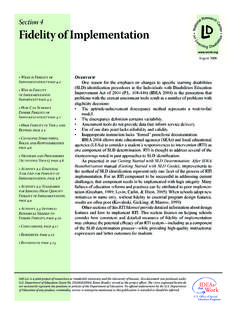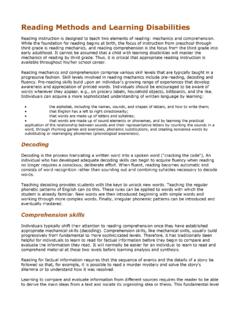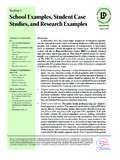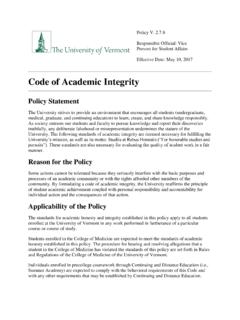Transcription of LEARNING DISABILITIES: HISTORICAL PERSPECTIVES
1 LEARNING disabilities : HISTORICAL PERSPECTIVES . Daniel P. Hallahan, University of Virginia, & Cecil D. Mercer, University of Florida Although the federal government's involvement in LEARNING disabilities through task forces, legislation, and funding has only been evident since the 1960s and 1970s, we can trace LEARNING disabilities ' roots back to at least the early 1800s. Thus, LEARNING disabilities may be one of the newest categories officially recognized by the Department of Education, but the origins of its conceptual foundation are as longstanding, or nearly as longstanding, as many of the other disability categories. We have divided the history of LEARNING disabilities into five periods: European Foundation Period (c. 1800. to 1920); Foundation Period (c. 1920 to 1960); Emergent Period (c.)
2 1960 to 1975); Solidification Period (c. 1975 to 1985); Turbulent Period (c. 1985 to 2000). Others before us (Lerner, 2000; Mercer, 1997; Wiederholt, 1974) have also divided the history into roughly similar EUROPEAN FOUNDATION PERIOD (C. 1800 TO 1920). During the European Foundation Period, there were two main lines of work relevant to the field of LEARNING disabilities . First, several groundbreaking discoveries in the field of neurology occurred during this time. Second, toward the end of this period, significant seminal articles and books on reading disabilities were published. Research on Brain-Behavior Relationships We can trace the origins of the field of LEARNING disabilities back to research in Europe on acquired brain pathology in adults. Men whose names still grace the pages of neurology textbooks conducted this research.
3 One of the primary objectives of this research was the attempt to match up areas of the brain to particular behaviors. A German physician, Franz Joseph Gall, is credited as the first major figure to explore the relationship between brain injury and mental impairment. Gall based much of his theorizing on observations he made of brain-injured soldiers. In a letter published in 1802, he conjectured that three separate parts of the brain are each responsible for what he termed: (a) vital sources (movement and sensation), (b) moral qualities (inclinations of the soul), and (c) intellectual qualities (Head, 1926;. Wiederholt, 1974). Of particular relevance to LEARNING disabilities , Gall is known for noting the effect of brain damage on what today would be termed Broca's aphasia. Gall's contributions in linking brain injury and aphasia, however, were largely overshadowed by his association with the phrenology school of thought, the belief that skull shape determines mental and personality attributes.
4 In later years, many considered him a quack. One exception was John Baptiste Bouillaud, Dean of the Medical School of the College of France (Wiederholt, 1974). In the 1820s, Bouillaud furthered Gall's work through autopsies of several patients with brain injury. Bouillaud did not ascribe to Gall's position on phrenology, but he did agree with much of what he had to say regarding the localization of brain functioning. Although Gall had hypothesized that the control of movement and sensory perception are located in the brain stem, Bouillard concluded that they are located in the cortex. In addition, he asserted that the frontal anterior lobes of the brain control speech. In the 1860s, Pierre Paul Broca did much to debunk the phrenologists through postmortem observations of adults with brain injury.
5 In particular, Broca is generally known for being the one who did the most to promote the idea that speech functions primarily reside in the left side of the He based his case on autopsies of several patients who had had impaired speech while alive. Broca concluded that a small section of the left side of the brain was responsible for speech. This area, which is located in the inferior left frontal lobe, has come to be called Broca's area; persons who have a particular constellation of speech problems involving slow, laborious, dysfluent speech are referred to as having Broca's aphasia. Some have questioned specific aspects of Broca's observations ( , Grodzinsky, in press), and neuroscientists now believe that damage to the right side of the brain can play a role, although limited, in causing speech problems.
6 However, Broca's claims have largely withstood the test of time. Carl Wernicke, a Polish-born physician whose family moved to Germany at an early age, was another major figure who explored brain localization during this period. In 1874, he published a book describing 10. case studies of brain-injured patients with language problems. However, the language disorders they possessed were different from those of Broca's patients as was the particular area of the brain affected (Wernicke, 1874). In contrast to Broca's subjects, Wernicke's patients had fluent and unlabored speech, but the sentences spoken were often meaningless. In addition, his cases had difficulties in recognizing and comprehending words. He called this disorder sensory aphasia, which has become known as Wernicke's aphasia. The particular area of the brain, now referred to as Wernicke's area, consists of a section of the left temporal lobe.
7 Research on Reading disabilities In 1872, Sir William Broadbent reported on the case of an intelligent adult patient who: after head symptoms, completely lost the power of reading either printed or written characters, while he could write readily and correctly from dictation or spontaneously. His conversation was good and his vocabulary extensive, but at times he was at a loss for a name, and he was quite unable, when asked, to name the simplest and most familiar object presented to his notice. The loss of power to read was of course a part of this more general loss of power to name. (Broadbent, 1872, p. 26). Five years later, Adolph Kussmaul (1877) reported on the case of an adult patient with no apparent disabilities other than a severe reading deficit. He asserted that a complete text-blindness may exist, although the power of sight, the intellect, and the powers of speech are intact.
8 In emphasizing the specificity of the reading problems, in isolation from other types of potential problems, Kussmaul gave birth to the idea of specific reading disability. Kussmaul labeled the condition word-blindness: In medical literature we find cases recorded as aphasia which should not properly be designated by this name, since the patients were still able to express their thoughts by speech and writing. They had not lost the power either of speaking or of writing; they were no longer able, however, although the hearing was perfect, to understand the words which they heard, or, although the sight was perfect, to read the written words which they saw. This morbid inability we will style, in order to have the shortest possible names at our disposition, word-deafness and word-blindness.
9 (Kussmaul, 1877, p. 770). A reciprocal academic relationship between two physicians John Hinshelwood from France and W. Pringle Morgan from England was the catalyst for extending this work on acquired word-blindness in adults to congenital word-blindness in children. Hinshelwood's first foray into research on word-blindness was with an adult whom he saw in 1894 and followed until his death in 1903. After his death an autopsy was performed, and Hinshelwood concluded that the section of the brain affected was the left angular gyrus, which is immediately posterior to Wernicke's area. Hinshelwood's paper describing this patient, published in 1895 in Lancet, prompted Morgan to report on what is believed to be the first published case of a child with congenital Morgan's case was a 14-year-old boy who had a history of severe reading problems: He seems to have no power of preserving and storing up the visual impression produced by words hence the words, though seen, have no significance for him.
10 His visual memory for words is defective or absent; which is equivalent to saying that he is what Kussmaul has termed word blind . Cases of word blindness are always interesting, and this case is, I think, particularly so. It is unique, so far as I know, in that it follows upon no injury or illness, but is evidently congenital, and due most probably to defective development of that region of the brain, disease of which in adults produces practically the same symptoms that is, the left angular gyrus. I may add that the boy is bright and of average intelligence in conversation. His eyes are normal, there is no hemianopsia, and his eyesight is good. The schoolmaster who has taught him for some years says that he would be the smartest lad in the school if the instruction were entirely oral. (Morgan, 1896, p.)

